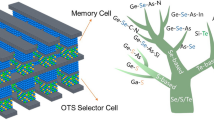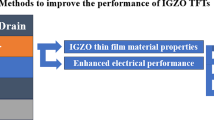Abstract
For the possible application of PZT thin films in ferroelectric non-volatile memories, the potential of low-voltage switching is a major requirement. By straightforward thickness scaling down to 75nm, operation voltage can be reduced to 1.5V without degradation of the hysteresis properties. However, interface effects increase the coercive field for thinner films, so that operation voltage does not scale linearly with thickness. In view of the large difference in coercive field between bulk and thin-films, on the other hand, material (and interface) optimization may constitute an interesting alternative route for further voltage scaling. By optimizing the composition and stoichiometry, less than 1.5V switching has indeed been obtained even for 150nm films. It is argued that an important material parameter affecting low-voltage switching behavior is the ferroelectric domain configuration and presence/absence of mobile domain walls in the PZT film.
Similar content being viewed by others
References
B.A. Tuttle, in Thin Film Ferroelectric materials and Devices, edited by R. Ramesh, Kluwer, Boston, MA, 1997, pp.145–165.
The superior low-voltage switching of SBT was attributed to lower Ec and also the possibility to make thinner (<100nm) films of good quality, see e.g.: J.F. Scott, F.M. Ross, C.A. Paz de Araujo, M.C. Scoot, and M. Huffman, MRS Bulleting, 21 (7), pp.33–39 (1996). For film thicknesses of, SBT shows switching already at 1V (while -2V is required for saturated switching), see [17].
G.J. Norga, L. Fè, D.J. Wouters, A. Bartic, and H. E. Maes, this proceedings.
F. Tsai and J.M. Cowley, App.Phys.Lett. 65(15), pp.1906–1908 (1994).
P.K. Larsen, G.J.M. Dormans, D.J. Taylor, and P.J. van Veldhoven, J.Appl.Phys. 76(4), p.2405–2413 (1994).
C.H. Ahn, T. Tybell, J.-M. Triscone, presented at the ECAPD IV’98 - ISAF XI’ 98 -Electroceramics VI’ 98 joined conference, Montreux, (Switzerland), Aug. 1998.
T. Hidaka, T. Marayuma, I. Sakai, M. Saito, L.A. Wills, R. Hiskes, S.A. Dicarolis, and J. Amano, Integrated Ferroelectrics 17(1-4), proceedings of the 9th International Symposium on Integrated Ferroelectric, March 1997, Santa Fe (NM), p.319 (1997).
C. Bjnrmander, K. Sreenivas, M. Duan, A.M. Grishin, and K.V. Rao, Appl.Phys.Lett. 66 (19), pp.2493–2495 (1995).
L.E. Sanchez, S.-Y. Wu, and I.K. Naik, Appl.Phys.Lett. 56 (24), pp.2399–2401 (1990).
K. Amanuma, T. Mori, T. Hase, T. Sakuma, A. Ochi, and Y. Miyasaka, Jpn. J.Appl.Phys. Vol.32 (1993), pp.4150–4153.
K. Aoki, Y. Fukuda, K. Numara, and A. Nishimura, Jpn. J.Appl.Phys., Vol.34 (1995), pp.746–751.
D.J. Wouters, G.J. Norga, F. Beckers, L. Bogaerts, presented at the 9th International Symposium on Integrated Ferroelectrics, March 1997, Santa Fe, NM (unpublished).
D.J. Wouters, G. Willems, E.G. Lee, H.E. Maes, Integrated Ferroelectrics, 15, pp.79–87 (1997).
D.J. Wouters, G.J. Norga, and H.E. Maes, presented at the 10th International Symposium on Integrated Ferroelectrics, March 1998, Monterey, CA (unpublished).
K. Ozaki, K. Nagata, J.of The American Ceramic Society, 56, No.2, pp.82–86 (1973).
S.B. Desu, C.H. Peng, L. Kammerdiner, P.J. Schuele, in Ferroelectric Thin Films, edited by E.R. Meyers and A. Kingon (Mat.Res.Soc.Symp.Proc. Vol.200, Pittsburgh, PA, 1990), pp.319–324.
K. Amanuma, T. Kunio, Jpn. J.Appl.Phys., 35 (1996), pp.5229–5231.
The term poling was originally used in the context of polarization alignment in ferroelectric ceramics, required to obtain pyroelectric and piezoelectric response. For these purposes, the resultant polarization alignment was more important than the concurrent modification of the domain structure. In our case, on the other hand, the modification of the domain structure is more important as it influences subsequent switching behavior. However, as both processes go together as a result of a high voltage application, we call both of them (electrical) “poling” (the term electrical contrasts with possible stress or thermal poling).
Author information
Authors and Affiliations
Corresponding author
Rights and permissions
About this article
Cite this article
Wouters, D.J., Norga, G.J. & Maes, H.E. Ultra-Thin PZT Films for Low-Voltage Ferroelectric Non-Volatile Memories. MRS Online Proceedings Library 541, 381–391 (1998). https://doi.org/10.1557/PROC-541-381
Published:
Issue Date:
DOI: https://doi.org/10.1557/PROC-541-381




